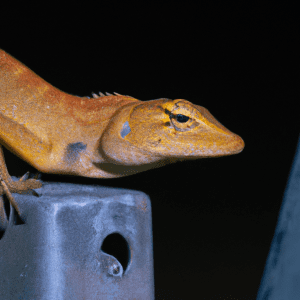Introduction to Monitor Lizard Ambient Temperature
Have you ever wondered why ambient temperature is crucial for the well-being of monitor lizards? Let me enlighten you on this fascinating topic.
Imagine yourself trekking through the dense rainforests of Southeast Asia, where monitor lizards roam freely. These remarkable creatures are highly adaptable to their surroundings, but one factor reigns supreme in their world: temperature.
As an expert in monitor lizard care, I’ve witnessed firsthand the impact of temperature on these reptiles. From basking under the sun to seeking shade when it gets too hot, monitor lizards are masters at regulating their body temperature.
Did you know that monitor lizards are ectothermic, meaning they rely on external sources to control their body temperature? This makes providing the right ambient temperature in their enclosure vital for their health and vitality.
Maintaining the ideal temperature range for monitor lizards can be a challenge for many reptile enthusiasts. But fear not! With proper monitoring and a few tricks up your sleeve, you can create a cozy habitat that mimics their natural environment.
So, how can you ensure your monitor lizard thrives in its environment? Stay tuned as I share expert tips and valuable insights to help you become a temperature wizard for your scaly companion. Let’s embark on this journey together and unlock the secrets of monitor lizard ambient temperature!
Importance of Maintaining the Right Temperature for Monitor Lizards
Maintaining the right ambient temperature for monitor lizards is crucial for their overall well-being. Imagine a scenario where your pet lizard’s comfort and health hinge on getting the temperature just right. It’s like Goldilocks searching for that perfect porridge – not too hot, not too cold, but just right.
When it comes to monitor lizards, we’re talking about creating a habitat that mimics their natural environment. Think of it as bringing a slice of the wild into your home. Picture lush vegetation, warm rocks, and a gentle breeze – that’s the kind of setting your pet lizard thrives in.
To achieve this, it’s essential to understand the ideal temperature range for these reptiles. Monitor lizards are cold-blooded creatures, relying on external sources to regulate their body temperature. So, providing a gradient of heat within their enclosure is key. It’s like offering them a buffet of warmth to choose from – they can bask in the sun-like heat or retreat to a cooler spot as needed.
Creating the perfect temperature zone for your monitor lizard isn’t just about comfort; it’s about ensuring their health and happiness. Just imagine the joy of seeing your pet lizard basking contentedly under a heat lamp, knowing you’ve created a little paradise for them right in your living room.
Understanding the Natural Habitat of Monitor Lizards
When it comes to the natural habitat of monitor lizards, it’s truly a fascinating realm to explore. These majestic creatures have evolved to thrive in diverse environments, from the arid deserts of Australia to the lush rainforests of Southeast Asia.
Imagine walking through the dense foliage of a tropical forest, the sun filtering through the canopy above, and suddenly coming across a massive monitor lizard basking on a rock. It’s a sight that never fails to leave me in awe of these incredible reptiles.
One interesting fact about monitor lizards is that they are highly adaptable creatures, capable of adjusting to a wide range of temperatures. However, despite their resilience, it’s crucial for their well-being in captivity to replicate their natural habitat as closely as possible.
Creating the ideal ambient temperature for monitor lizards is essential for their health and happiness. By understanding their natural environment and providing them with the right temperature gradient in their enclosure, you can ensure that they thrive and exhibit their natural behaviors.
So, the next time you observe your monitor lizard basking under a heat lamp or seeking out a cooler spot in their habitat, remember that you are playing a vital role in mimicking their natural habitat and supporting their overall well-being. Let’s delve deeper into the world of monitor lizard ambient temperature and discover how to create the perfect environment for these incredible reptiles.
Ideal Ambient Temperature Range for Monitor Lizards
Alright, let’s dive into the fascinating world of monitor lizard ambient temperature! Picture this: in the wild, these magnificent creatures thrive in a variety of environments. From the sweltering heat of deserts to the lush humidity of tropical forests, monitor lizards have adapted to different temperature ranges. It’s crucial to replicate these conditions in captivity to ensure their well-being. Did you know that monitor lizards are ectothermic, meaning they rely on external heat sources to regulate their body temperature? This makes maintaining the right ambient temperature in their enclosure essential for their health and behavior. When setting up your lizard’s habitat, aim for a temperature gradient with warm basking spots and cooler areas to allow them to thermoregulate effectively. Keep a close eye on the temperature levels using a reliable thermometer and make adjustments as needed. Remember, monitor lizards are sensitive to temperature fluctuations, which can impact their metabolism and overall health. By providing a comfortable and stable environment, you’re not just creating a cozy home for your scaly friend but also promoting their physical and mental well-being. So, how can you ensure your monitor lizard stays comfortable and healthy in their habitat? Let’s explore some practical tips and expert advice to help you become a temperature guru for your reptilian companion.
Monitoring and Regulating Temperature in a Lizard Enclosure
Have you ever noticed how monitor lizards react to temperature changes in their environment? It’s truly fascinating. These creatures have a unique way of communicating their comfort levels without saying a word. As an expert in all things monitor lizard, let me share some insights into these behavioral signs. When monitor lizards are content with the ambient temperature, they often bask in the sunlight, absorbing the warmth to regulate their body temperature. It’s like their version of a relaxing day at the beach. On the flip side, if the temperature is too high or too low, you might notice them seeking out cooler or warmer spots in their habitat. It’s their way of telling you, “Hey, I need a temperature adjustment here!” Understanding these cues can help you fine-tune their living conditions for optimal health and well-being. So, next time you observe your monitor lizard’s behavior, pay close attention to how they interact with their surroundings. It’s like deciphering a secret code that only they can decode. What other quirky behaviors have you noticed in your monitor lizard when it comes to temperature regulation? Share your experiences below!
Common Mistakes to Avoid When Managing Lizard Temperature
Maintaining the right temperature for your monitor lizard is crucial to their well-being and overall health. Think of it as creating a cozy little haven for your scaly friend, where they can bask and thrive. Now, let me share a little secret with you about managing lizard temperature – it’s all about finding that sweet spot where they feel just right.
Imagine this: you walk into a room that’s too cold or too hot, and you immediately want to leave. Well, monitor lizards are no different. They need that perfect balance to feel comfortable and content. It’s like Goldilocks searching for the ideal porridge – not too hot, not too cold, just right.
Now, here’s a practical tip for you: invest in a reliable thermometer to monitor the temperature in your lizard’s enclosure regularly. This simple tool can make a world of difference in ensuring your pet’s happiness and health. Remember, a happy lizard is a healthy lizard!
So, let me ask you this: Have you ever considered how the temperature affects your own mood and well-being? Just like us, monitor lizards respond to their environment, and maintaining the right temperature is key to their happiness. By understanding and catering to their needs, you’re not just a pet owner – you’re a lizard whisperer, creating a harmonious habitat for your scaly companion.
Tips for Creating a Comfortable Environment for Monitor Lizards
Alright, folks, let’s dive into creating a comfortable environment for our monitor lizard buddies. Imagine this – your monitor lizard lounging contentedly in its enclosure, basking under the warm glow of the heat lamp. Picture the serene look on its scaly face as it blissfully absorbs the right amount of heat to regulate its body temperature. Ensuring the perfect ambient temperature for your monitor lizard is like being their personal climate control manager. You hold the key to their comfort and well-being.
Now, here’s a practical tip to help you ace the temperature game: consider using a combination of heat sources to mimic the natural conditions of a monitor lizard’s habitat. By incorporating heat lamps, heating pads, and basking spots, you can create temperature gradients within the enclosure, allowing your lizard to move around and regulate its body temperature effectively. This setup not only provides physical warmth but also promotes natural behaviors and overall health.
Imagine the satisfaction of seeing your monitor lizard thriving in an environment tailored to meet its temperature needs. By mastering the art of temperature management, you’re not just a pet owner – you’re a lizard whisperer, attuned to the subtle cues and requirements of these fascinating creatures. So, go ahead, set the stage for your monitor lizard’s comfort and happiness, and watch as they bask in the warmth of your expert care.
Behavioral Signs of Monitor Lizards in Response to Temperature Changes
Have you ever noticed how your monitor lizard responds to changes in temperature? It’s quite fascinating. These creatures are so in tune with their environment that even the slightest shift can elicit a noticeable reaction.
For instance, when the temperature drops below their preferred range, monitor lizards may become lethargic or seek out warmer spots to bask in. On the other hand, if it gets too hot, they might retreat to cooler areas to avoid overheating.
Understanding these behavioral cues can give you valuable insights into your lizard’s well-being. By observing how they react to temperature changes, you can fine-tune their enclosure to ensure they are comfortable and thriving.
Imagine being able to communicate with your monitor lizard through their actions and preferences. It’s like having a secret language that only the two of you understand.
So, next time you notice your monitor lizard seeking out a sunny spot or retreating to a shady corner, pay attention. They’re trying to tell you something about their temperature preferences. It’s all part of the fascinating world of monitor lizard care.
Expert Insights on Providing Optimal Temperature for Monitor Lizards
As an expert in monitor lizard care, providing your scaly friend with the perfect ambient temperature is key. Monitor lizards may seem tough on the outside, but they’re quite sensitive when it comes to their environment. Picture this: you’ve set up a cozy enclosure for your monitor lizard, complete with all the necessities. But wait, are you sure the temperature is just right? Monitor lizards need specific heat levels to thrive. It’s not simply a matter of turning up the heat or cranking the AC. You’ve got to create a Goldilocks scenario – not too hot, not too cold, but just perfect. Imagine being in a room that’s either freezing or sweltering – not a pleasant experience, right? Well, your monitor lizard feels the same way. So, how do you find that sweet spot of temperature perfection for your scaly pal? It’s all about understanding their natural habitat and behavior. By mimicking their wild environment, you can ensure your monitor lizard feels right at home. Remember, a happy lizard is a healthy lizard! So, take the time to monitor and regulate the temperature in their enclosure regularly. Trust me, your monitor lizard will thank you with lots of lizardy smiles – or at least with content basking under their heat lamp.
Conclusion: Ensuring the Well-being of Your Monitor Lizard
Have you ever wondered about the secret to keeping your monitor lizard happy and healthy? Well, let me tell you, it all boils down to one crucial factor: ambient temperature. Yes, you heard me right! The temperature in your lizard’s habitat can make all the difference in their well-being.
Imagine this – you’re out in the scorching desert sun, sweating buckets and searching for shade. That’s how your monitor lizard feels if the temperature isn’t just right. These majestic creatures hail from warm climates, so it’s vital to replicate those conditions in captivity.
Maintaining the ideal ambient temperature is like hitting the jackpot for your monitor lizard. It’s not just about comfort; it’s about their very survival. They rely on external heat sources to regulate their body temperature and digest food properly.
Here’s a fun fact for you: monitor lizards are ectothermic, meaning they depend on external heat sources to warm up. So, providing the right temperature gradient in their enclosure is key to their health and happiness.
Now, picture this: you walk into your lizard’s habitat, and they are basking under a heat lamp, content and thriving. That’s the goal we all aim for – a happy and healthy monitor lizard soaking up the warmth they need to thrive.
So, my fellow lizard enthusiasts, let’s dive deeper into the fascinating world of monitor lizard ambient temperature and unlock the secrets to keeping these incredible creatures in the pink of health.




